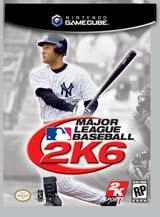Baseball fans have few games to choose from this year, with 2K Games' scoop of the MLB Players Association license. Major League Baseball 2K6 offers up a wide array of game modes for you to explore, enough to keep any fan going through baseball season and beyond. You have comprehensive Franchise and GM Career modes, your basic exhibition options, and even the World Baseball Classic. For the first time, you can pit Fidel Castro's Cuban team against Hugo Chavez's Venezuelan team in an all-socialist/communist championship game. The create-a-player feature allows you to create the likenesses of your favorite little league players or co-workers, and if you're bored of non-stop days at the ballpark, you could always spend some time playing air hockey or darts in your personal gaming lounge.
The visuals in MLB 2K6 leave something to be desired, for a number of reasons. A careful eye to detail will pick up on the slightly jittery frame rate that keeps the motion of a player's bat from looking smooth and natural. The facial modeling isn't up to par with what we've seen in other sports titles, and many of the big-name players don't bear a proper likeness to the actual athletes. The lackluster presentation takes away from what could have been a very attractive game, with some team logos added in a sloppy way, either stretched out of proportion or clipped to make them fit into a menu screen. On the other hand, the architecture behind the team stadiums was very well-handled, going hand in hand with polished textures for the ballpark advertisements and other minutiae that bring the parks to life. Interestingly enough, many of the cutscenes were cut right out of the game, most alarmingly those of batters stepping up to bat. When one batter is sent back home, the next man in the lineup immediately takes his place in the box, without so much as a mention of his name or his stats. There's no transition between innings either, so as the third batter goes down, the next team instantly goes up to bat. Whether this was an intentional move to draw less attention to the character models or just an effort to speed up the pace of the game we'll never know, but it's awkward to say the least.
When you play the Franchise and GM Career modes, you're urged to make use of Insider's Edge, the game's scouting report system. Much like a subscription to your favorite gaming website, Insider's Edge offers you benefits at a cost. The price on individual scouting reports varies based on the proximity to your next game against that team on the schedule, so you can get better deals by purchasing reports in advance. If you get a report on a team's star batter, for example, you'll learn what parts of the strike zone are hot and cold for them, their first pitch tendencies, and all sorts of other useful information that will give you that necessary advantage come game time. The same is true for pitching reports, so you can get ready to either ease back and sit on the pitch or come out swinging on a full count. This emphasis on player scouting translates nicely into gameplay, as you receive certain useful advantages when facing scouted players. Your catcher will recommend pitches that the opposing batter is susceptible to based on situation, and generally, you'll always want to purchase reports for the opposition's pitcher and best batters.
The pitching game is perhaps the most satisfying and well-handled aspects of MLB 2K6. The way it basically works is each pitcher has a repertoire of pitches available to them, ranging from the standby fastballs and changeups, to power curves, knuckle balls, and split-finger fastballs. The only thing you're missing is the spitter. Once you've selected your pitch, you'll aim a baseball reticle, either in or out of the strike zone. The interesting thing is that this isn't where you're throwing the ball, but instead it's the ball's break point. If you're throwing a fastball, with little movement on it, then it will go directly towards this spot. Curveballs, on the other hand, can end up quite far from this breakpoint, depending on how much effort is put into the pitch. To put more effort into your pitches, you hold down the button associated with the specific pitch, which puts more break into your pitches, but also greatly reduces your pitcher's stamina and affects the accuracy of the pitch. There's little as satisfying in a baseball game as tossing a wicked breaking curve and making an opposing star batter look completely foolish, swinging at a curve that ends up down at his ankles.





 Poor
Poor



